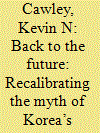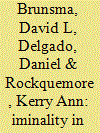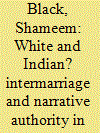|
|
|
Sort Order |
|
|
|
Items / Page
|
|
|
|
|
|
|
| Srl | Item |
| 1 |
ID:
143677


|
|
|
|
|
| Summary/Abstract |
This article reviews Korea’s multicultural past, while also tracing the evolution of the myth of ethnic Korean homogeneity via the Tan’gun myth, whose earliest extant record dates from the thirteenth century. It highlights how the myth was recalibrated in the twentieth century in the face of Japanese cultural imperialism, and used to promote a nationalist, homogenous Korean identity. By exploring past intercultural exchanges and developments, this article also illustrates how this modern ‘homogenous’ identity has been misconstructed by both North and South Korea. This is now especially anachronistic for contemporary South Korea, which is fast becoming multiracial and multicultural, but where biracial people are often discriminated against. Finally, I argue that by deconstructing the Tan’gun myth, one discovers that it already inherently possesses the potential to resolve the problematic nationalistic myth of ethnic homogeneity in a growing multiracial society, which still, in the twenty-first century, emphasises racial ‘purity’.
|
|
|
|
|
|
|
|
|
|
|
|
|
|
|
|
| 2 |
ID:
123918


|
|
|
|
|
| Publication |
2013.
|
| Summary/Abstract |
Although researchers have investigated Multiracials for their racial identity 'choices', many scholars continue to conceptualise racial identity as monolithic. This article both problematises and extends the notion of racial identity with an 'identity matrix'. This concept grounds the sociological processes of constructing and deploying a racial identity as strategic and agentic in interactional, political, cultural, physical (embodiment) and institutional contexts. Using insights from survey data from 231 black-white Multiracial young adults and follow-up in-depth interviews with 24 of these respondents, we develop the concept of 'identity matrix' both theoretically and empirically. This article provides heuristic results that we hope will encourage more development of methodological and theoretical complexity in the study of racial identity, allowing scholars to think about the various identities of Multiracials, the possibility of and conditions enabling an emergent Multiracial consciousness, as well as the socio-cognitive structure and active deployment of identity matrices across other social groups.
|
|
|
|
|
|
|
|
|
|
|
|
|
|
|
|
| 3 |
ID:
120710


|
|
|
|
|
| Publication |
2013.
|
| Summary/Abstract |
How does intermarriage affect a storyteller? In this essay, I seek to examine literary narratives of South Asian family formation that take late twentieth-century intermarriages-particularly between Indian men and white American women-as their central governing trope. This phenomenon raises two linked questions: first, how do South Asian families recruit or reject individuals within constructs of South Asian identity; and second, to what extent do individuals not of South Asian descent gain the authority to imagine and re-imagine the contours of their multiracial family? I here examine the work of the white American writer Robbie Clipper Sethi, whose novel-in-stories, The Bride Wore Red (1996), tells the unfolding saga of a multiracial South Asian family in the United States and India. These narratives of white women socialised into ambivalent places within larger South Asian families, I argue, figure larger anxieties about imaginative representation across the mobile borders of what is considered one's culture. The family structure emerges as a contradictory space that empowers this border-crossing representational authority by simultaneously calling this authority into question.
|
|
|
|
|
|
|
|
|
|
|
|
|
|
|
|
|
|
|
|
|